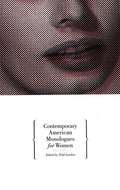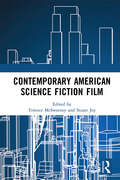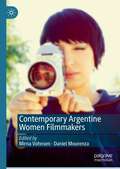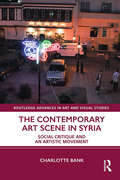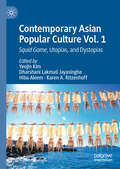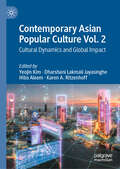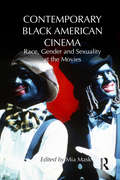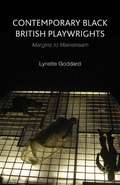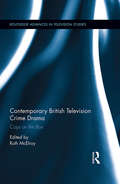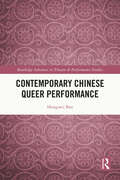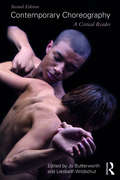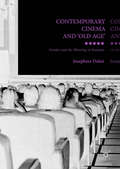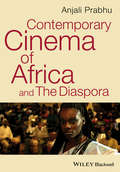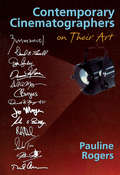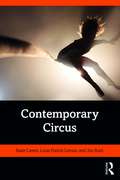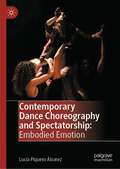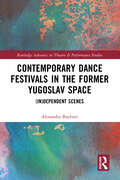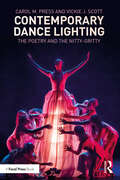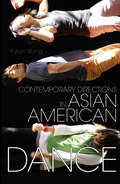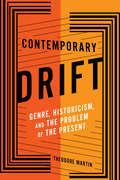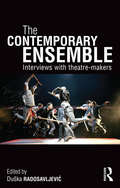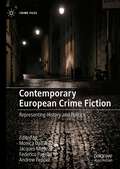- Table View
- List View
Contemporary American Monologues for Women
by Todd LondonAudition monologues for female characters selected from recent works by American playwrights including Tony Kushner, Jon Robin Baitz, Constance Congdon, Paula Vogel, Donald Margulies, Emily Mann, Eric Bogosian, Nicky Silver, and others. Unique to the TCG monologue series is a bibliography of other works by the playwrights included.
Contemporary American Science Fiction Film
by Terence McSweeneyContemporary American Science Fiction Film explores and interrogates a diverse variety of popular and culturally relevant American science fiction films made in the first two decades of the new millennium, offering a ground-breaking investigation of the impactful role of genre cinema in the modern era. Placing one of the most popular and culturally resonant American film genres broadly within its rich social, historical, industrial, and political context, the book interrogates some of the defining critical debates of the era via an in-depth analysis of a range of important films. An international team of authors draw on case studies from across the science fiction genre to examine what these films can tell us about the time period, how the films themselves connect to the social and political context, how the fears and anxieties they portray resonate beyond the screen, and how the genre responds to the shifting coordinates of the Hollywood film industry. Offering new insights and perspectives on the cinematic science fiction genre, this volume will appeal primarily to scholars and students of film, television, cultural and media studies, as well as anyone interested in science fiction and speculative film.
Contemporary Argentine Women Filmmakers
by Mirna Vohnsen Daniel MourenzaThis edited volume offers a wide-ranging picture of Argentine women filmmakers’ contribution to the film industry from the 1980s to the present by bringing together the work of highly acclaimed and emerging directors. Through thirteen critical essays by leading scholars in the field of Argentine cinema, the book acknowledges that contemporary women filmmakers have transformed the cinema of Argentina by questioning, challenging and debunking hegemonic patriarchal systems of representation. With a focus on women’s voices and experiences, the contributions redress both the under-representation of women and girls onscreen and the perpetuation of stereotypes, while exploring the innovative aesthetics used by these filmmakers.
The Contemporary Art Scene in Syria: Social Critique and an Artistic Movement (Routledge Advances in Art and Visual Studies)
by Charlotte BankThis book focuses on the expanding contemporary art scene in Syria, particularly Damascus, during the first decade of the twenty-first century. The decade was characterized by a high degree of experimentation as young artists began to work with artistic media that were new in Syria, such as video, installation and performance art. They were rethinking the role of artists in society and looking for ways to reach audiences in a more direct manner and address socio-cultural and socio-political issues. The Contemporary Art Scene in Syria will be of interest to scholars of global and Middle Eastern art studies, and also to scholars interested in the recent social and cultural history of Syria and the wider Middle East.
Contemporary Asian Popular Culture Vol. 1: Squid Game, Utopias, and Dystopias
by Yeojin Kim Dharshani Lakmali Jayasinghe Hiba Aleem Karen A. RitzenhoffThis first of two volumes explores how contemporary Asian popular culture reflects and critiques social issues. The authors, from different scholarly backgrounds, examine how shows like Squid Game present a scathing critique of oppressive socio-economic structures, conceptualize national heterotopias, utopias, and dystopias, and facilitate understanding of identity formation and discourses of resistance. The volume encompasses chapters discussing themes that intersect gender, race, politics, and social dynamics. It showcases ongoing developments in Asian popular culture in the wake of the global popularity of Squid Game and in anticipation of its second season release in December 2024.
Contemporary Asian Popular Culture Vol. 2: Cultural Dynamics and Global Impact
by Yeojin Kim Dharshani Lakmali Jayasinghe Hiba Aleem Karen A. RitzenhoffThis second of two volumes explores broader cultural, economic, and socio-political dynamics exchanged between Asian popular media and the world. The authors analyze how the said media navigate complex global markets and technological advancements. They discuss how dissemination and consumption of Asian popular culture, such as early Chinese-language movie theaters, Netflix, subtitling of Asian content, impact the popularity of cultural contents. They also examine the portrayal of ajummas (middle-aged women) in Korean TV and film, along with the varying representations of utopia and dystopia embedded in Asian science fiction. This volume illustrates the soft power of media in transnational exchanges.
Contemporary Black American Cinema: Race, Gender and Sexuality at the Movies
by Mia MaskContemporary Black American Cinema offers a fresh collection of essays on African American film, media, and visual culture in the era of global multiculturalism. Integrating theory, history, and criticism, the contributing authors deftly connect interdisciplinary perspectives from American studies, cinema studies, cultural studies, political science, media studies, and Queer theory. This multidisciplinary methodology expands the discursive and interpretive registers of film analysis. From Paul Robeson’s and Sidney Poitier’s star vehicles to Lee Daniels’s directorial forays, these essays address the career legacies of film stars, examine various iterations of Blaxploitation and animation, question the comedic politics of "fat suit" films, and celebrate the innovation of avant-garde and experimental cinema.
Contemporary Black British Playwrights: Margins to Mainstream
by L. GoddardThis book examines the socio-political and theatrical conditions that heralded the shift from the margins to the mainstream for black British Writers, through analysis of the social issues portrayed in plays by Kwame Kwei-Armah, debbie tucker green, Roy Williams, and Bola Agbaje.
Contemporary British Television Crime Drama: Cops on the Box (Routledge Advances in Television Studies)
by Ruth McElroyContemporary British Television Crime Drama examines one of the medium’s most popular genres and places it within its historical and industrial context. The television crime drama has proved itself capable of numerous generic reinventions and continues to enjoy some of the highest viewing figures. Crime drama offers audiences stories of right and wrong, moral authority asserted and resisted, and professionals and criminals, doing so in ways that are often highly entertaining, innovative, and thought provoking. In examining the appeal of this highly dynamic genre, this volume explores how it responds not only to changing social debates on crime and policing, but also to processes of hybridization within the television industry itself. Contributors, many of whom are leading figures in UK television studies, analyse popular series such as Broadchurch, Between the Lines, Foyle’s War, Poirot, Prime Suspect, Sherlock and Wallander. Essays examine the main characteristics of television crime drama production, including the nature of trans-Atlantic franchises and literary and transnational adaptations. Adopting a range of feminist, historical, aesthetic and industrial approaches, they offer incisive interrogations that provide readers with a rich understanding of the allure of crime drama to both viewers and commissioners.
Contemporary Chinese Queer Performance (Routledge Advances in Theatre & Performance Studies)
by Hongwei BaoIn this ground-breaking study, Hongwei Bao analyses queer theatre and performance in contemporary China. This book documents various forms of queer performance – including music, film, theatre, and political activism – in the first two decades of the twenty first century. In doing so, Bao argues for the importance of performance for queer identity and community formation. This trailblazing work uses queer performance as an analytical lens to challenge heteronormative modes of social relations and hegemonic narratives of historiography. It will be of great interest to students and scholars of theatre and performance studies, gender and sexuality studies and Asian studies.
Contemporary Choreography: A Critical Reader
by Jo Butterworth Liesbeth WildschutFully revised and updated, this second edition of Contemporary Choreography presents a range of articles covering choreographic enquiry, investigation into the creative process, and innovative challenges to traditional understandings of dance making. Contributions from a global range of practitioners and researchers address a spectrum of concerns in the field, organized into seven broad domains: Conceptual and philosophical concerns Processes of making Dance dramaturgy: structures, relationships, contexts Choreographic environments Cultural and intercultural contexts Challenging aesthetics Choreographic relationships with technology. Including 23 new chapters and 10 updated ones, Contemporary Choreography captures the essence and progress of choreography in the twenty-first century, supporting and encouraging rigorous thinking and research for future generations of dance practitioners and scholars.
Contemporary Cinema and 'Old Age': Gender and the Silvering of Stardom
by Josephine DolanThis book is the first to explore ‘old age’ in cinema at the intersection of gender, ageing, celebrity and genre studies. It takes its cue from the dual meanings of ‘silvering’ – economics and ageing – and explores shifting formulations of ‘old age’ and gender in contemporary cinema. Broad in its scope, the book establishes the importance of silver audiences to the survival of cinema exhibition while also forging connections between the pleasures of ‘old age’ films, consumer culture, the ‘economy of celebrity’ and the gendered silvering of stardom. The chapters examine gendered genres such as romantic comedies, action and heist movies, the prosthetics of costume, and CGI enabled age transformations. Through this analysis, Josephine Dolan teases out the different meanings of ageing masculinity and femininity offered in contemporary cinema. She identifies ageing femininity as the pathologised target of rejuvenation while masculine ageing is seen to enhance an enduring youthfulness. This book has interdisciplinary appeal and will engage scholars interested in ‘old age’ and gender representations in contemporary cinema.
Contemporary Cinema of Africa and the Diaspora
by Anjali PrabhuAnalyzing art house films from the African continent and the African diaspora, this book showcases a new generation of auteurs with African origins from political, aesthetic, and spectatorship perspectives. Focuses on art house cinema and discusses commercial African cinema Enlarges our understanding of African film to include thematic and aesthetic influence Highlights aesthetic and political aspects including racial identity, women’s issues, and diaspora Heavily illustrated with over 90 film stills Features selected stills integral to the filmic analysis in full color Moves beyond Western-oriented analytical paradigms
Contemporary Cinematographers on Their Art
by Pauline B RogersThe twelve interviews in this book cover all aspects of cinematography from pre-production planning to post-production, special effects, aerial photography, and second unit. Each interview gives a behind-the-scenes look at how some of the most popular shots in movies and television shows were lit and captured. Technically and philosophically oriented, Contemporary Cinematographers on Their Art explores the tools, trends, personalities, and professional achievements of contemporary cinematographers, highlighting the behind-the-scenes struggles of the business of making motion pictures. Each chapter delves into the personal challenges, political properties, inter-departmental interactions, and artistic achievements of the artists who bring scripts to life through their choice of cameras, lights, lenses, filters, gels, and other supporting equipment.Covering a variety of film and television genres--from soaps to half-hour sitcoms, to cable and network productions and low- and big-budget features--each interview explores the tools cinematographers use to capture their shots, from traditional equipment to innovative camera and lighting "toys," as well as the integration of mechanical and computer graphic effects.
Contemporary Circus: Conversations With Creators
by Katie Lavers Louis Patrick Leroux Jon BurttIn this volume, twenty-four creators come together with three scholars to discuss Contemporary Circus, bridging the divide between practice and theory. Lavers, Leroux, and Burtt offer conversations across four key themes: Apparatus, Politics, Performers, and New Work. Extensively illustrated with fifty photos of Contemporary Circus productions, and extensively annotated, Contemporary Circus thematically groups and contextualises extracts of conversations to provide a sophisticated and wide-ranging study supported by critical theory. Of interest to both practitioners and scholars, Contemporary Circus uses the lens of ‘contestation,’ or calling things into question, to provide a portal into ways of seeing today’s circus performance. Conversations with: Lachlan Binns and Jascha Boyce (Gravity and Other Myths), Tilde Björfors (Cirkus Cirkör), Kim ‘Busty Beatz’ Bowers (Hot Brown Honey), Shana Carroll (The 7 Fingers), David Clarkson (Stalker), Philippe Decouflé (Compagnie DCA), Fez Faanana (Briefs), Mike Finch (Circus Oz), Daniele Finzi Pasca (Compagnia Finzi Pasca), Sean Gandini (Gandini Juggling), Firenza Guidi (ElanFrantoio, NoFit State Circus), Jo Lancaster and Simon Yates (Acrobat), Johann Le Guillerm (Cirque Ici), Yaron Lifschitz (Circa), Chelsea McGuffin (Company 2), Phia Ménard (Compagnie Non Nova), Jennifer Miller (Circus Amok), Adrien Mondot (Compagnie Adrien M and Claire B), Charlotte Mooney and Tina Koch (Ockham’s Razor), Philippe Petit (high wire artist), and Elizabeth Streb (STREB EXTREME ACTION).
Contemporary Dance Choreography and Spectatorship: Embodied Emotion
by Lucía Piquero ÁlvarezThis book offers an approach which unites choreographic and spectatorial perspectives, and argues for dance itself—its materials, its structures—as a medium of emotional communication. Contemporary dance often seems to contend with issues of understanding, regularly being “read” in “languages” which alienate it. Even if emotion seems a significant part of people’s engagement with dance, its workings are often surrounded by an air of mysticism. Engaging with these issues, this study investigates the experience of emotion in Euro-American contemporary dance theatre. It questions its dependence on the artist’s personal emotions, and the assumption that it is mediated by representational meaning. Instead, this book proposes that the emotional import of dance emerges from an interplay between perceptual properties and symbolic elements in an embodied affective cognitive experience. This experience includes the background of the spectator as well as the context of work, choreographer, performer(s) and other creative agents.
Contemporary Dance Festivals in the Former Yugoslav Space: (in)dependent Scenes (Routledge Advances in Theatre & Performance Studies)
by Alexandra BaybuttThis book expands the understanding of conditions defining the creation and circulation of contemporary dance that differ across Europe. It focuses on festival-making connected with the Balkan regional project ‘Nomad Dance Academy’ (NDA), and highlights collective approaches to sustain a theorisation of festivals using the concepts of dissensus and imperceptible politics. Drawing from anthropological methods, three festivals PLESkavica, Slovenia; Kondenz, Serbia and LocoMotion, North Macedonia, are explored through social, political and historical currents affecting curatorial practice. This book closely follows how festival-makers navigate the values of international development that during and after the Yugoslav wars looked to art as part of peacekeeping and nation-building processes. This coincided with increasing discourse and practices of contemporary dance that gained momentum in the 1980s alongside European festivalisation. I show how contemporary dance acts as an agent for transformation, but also a carrier of older forms of social organisation, reflecting methods and values of Yugoslav Worker Self-management that are deployed by the groups creating the festivals. This book will be of interest to dance scholars as well as researchers tracing the long-term effects of the dissolution of the Socialist Federal Republic of Yugoslavia.
Contemporary Dance Lighting: The Poetry and the Nitty-Gritty
by Carol M. Press Vickie J. ScottContemporary Dance Lighting: The Poetry and the Nitty-Gritty dynamically guides students toward aesthetically, creatively, and skillfully becoming lighting designers for dance in the 21st century. The book is organized in three parts, covering everything from the aesthetic considerations of lighting for dance to the tools and technology designers use to create compelling artistry. Part I, "Beginnings" establishes context, explaining the structure of the book and illuminating the history of contemporary dance and lighting. Part II, "The Poetry" elaborates on the key artistic and aesthetic elements of contemporary dance lighting: visual narrative; controllable functions and qualities of light; use of space, color, and time; importance and intricacies of collaboration; and continual effects and evolution of technology. Part III, "The Nitty-Gritty" steers students through the technical knowledge and skills necessary to design lighting, including understanding your tools and positioning instruments; creating layered light plots; organizing extensive paperwork; and archiving. The dance Artifice, choreographed by Jerry Pearson, is sequentially explored throughout the book to convey key concepts. "Further Reflections" conclude each chapter, written by a diverse group of renowned professionals, inviting young designers directly into the world of lighting design. This textbook is for use in Lighting Design and Design for Dance Lighting courses at the university level, along with professional training programs.
Contemporary Directions in Asian American Dance (Studies in Dance History)
by Yutian WongThe definition of Asian American dance is as contested as the definition of "Asian American." The contributors to this volume address such topics as the role of the 1960s Asian American movement in creating Japanese American taiko groups, and the experience of internment during World War II influencing butoh dance in Canada. Essays about artists such as Jay Hirabayashi, Alvin Tolentino, Shen Wei, Kun-Yang Lin, Yasuko Yokoshi, Eiko & Koma, Sam Kim, Roko Kawai, and Denise Uyehara look closely at the politics of how Asian aesthetics are set into motion and marketed. The volume includes first-person narratives, interviews, ethnography, cultural studies, performance studies, and comparative ethnic studies.
Contemporary Drift: Genre, Historicism, and the Problem of the Present (Literature Now)
by Theodore MartinWhat does it mean to call something “contemporary”? More than simply denoting what’s new, it speaks to how we come to know the present we’re living in and how we develop a shared story about it. The story of trying to understand the present is an integral, yet often unnoticed, part of the literature and film of our moment. In Contemporary Drift, Theodore Martin argues that the contemporary is not just a historical period but also a conceptual problem, and he claims that contemporary genre fiction offers a much-needed resource for resolving that problem.Contemporary Drift combines a theoretical focus on the challenge of conceptualizing the present with a historical account of contemporary literature and film. Emphasizing both the difficulty and the necessity of historicizing the contemporary, the book explores how recent works of fiction depict life in an age of global capitalism, postindustrialism, and climate change. Through new histories of the novel of manners, film noir, the Western, detective fiction, and the postapocalyptic novel, Martin shows how the problem of the contemporary preoccupies a wide range of novelists and filmmakers, including Zadie Smith, Colson Whitehead, Vikram Chandra, China Miéville, Kelly Reichardt, and the Coen brothers. Martin argues that genre provides these artists with a formal strategy for understanding both the content and the concept of the contemporary. Genre writing, with its mix of old and new, brings to light the complicated process by which we make sense of our present and determine what belongs to our time.
The Contemporary Ensemble: Interviews with Theatre-Makers
by Duška Radosavljević‘Dr. Radosavljević has an excellent and extensive grasp of her subject, and deep understanding of not only the history of these groups, but how they function, and how each contributes to the field of ensemble theatre.’ – David Crespy, University of Missouri, USA Questions of ensemble – what it is, how it works – are both inherent to a variety of Western theatre traditions, and re-emerging and evolving in striking new ways in the twenty-first century. The Contemporary Ensemble draws together an unprecedented range of original interviews with world-renowned theatre-makers in order to directly address both the former and latter concerns. Reflecting on ‘the ensemble way of working’ within this major new resource are figures including: Michael Boyd, Hermann Wündrich, Yuri Butusov, Max Stafford-Clark, Elizabeth LeCompte, Lyn Gardner, Adriano Shaplin, Phelim McDermott; and Emma Rice; representing companies including: The RSC; The Berliner Ensemble; The Satirikon Theatre; Out of Joint; The Wooster Group; Kneehigh Theatre; Song of the Goat; The Riot Group; The Neo-Futurists; Shadow Casters; and Ontroerend Goed. All 22 interviews were conducted especially for the collection, and draw upon the author’s rich background working as scholar, educator and dramaturg with a variety of ensembles. The resulting compendium radically re-situates the ensemble in the context of globalisation, higher education and simplistic understandings of ‘text-based’ and ‘devised’ theatre practice, and traces a compelling new line through the contemporary theatre landscape.
Contemporary European Crime Fiction: Representing History and Politics (Crime Files)
by Monica Dall’Asta Jacques Migozzi Federico Pagello Andrew PepperThis book represents the first extended consideration of contemporary crime fiction as a European phenomenon. Understanding crime fiction in its broadest sense, as a transmedia practice, and offering unique insights into this practice in specific European countries and as a genuinely transcontinental endeavour, this book argues that the distinctiveness of the form can be found in its related historical and political inquiries. It asks how the genre’s excavation of Europe’s history of violence and protest in the twentieth century is informed by contemporary political questions. It also considers how the genre’s progressive reimagining of new identities forged at the crossroads of ethnicity, gender, and sexuality is offset by its bleaker assessment of the corrosive effects of entrenched social inequalities, political corruption, and state violence. The result is a rich, vibrant collection that shows how crime fiction can help us better understand the complex relationship between Europe’s past, present, and future. Seven chapters are available open access under a Creative Commons Attribution 4.0 International License via link.springer.com.
Contemporary European Science Fiction Cinemas (Palgrave European Film and Media Studies)
by Aidan PowerContemporary European Science Fiction Cinemas charts the evolution of European science fiction cinema in the 21st century, a period in which Europe itself has faced myriad crises. Key to this study is an exploration of how European science fiction responds to prevalent issues such as the financial crisis, political extremism and violence, large-scale migration and indeed the potential breakup of the European Union itself. What futures does science fiction cinema envision for Europe? Is it capable of moving beyond dystopian visions of a continent beset by seemingly omnipresent turbulence? Emphasising science fiction’s unique ability to estrange, exploit and reflect upon popular concerns, this book directly engages with such questions, accounting for ongoing mutations in the very nature of the European project as it does so.
Contemporary European Theatre Directors
by Maria M. Delgado Dan Rebellato'An invaluable book that we shall all be using for a long time to come' - Michael Billington Contemporary European Theatre Directors is an ambitious and unprecedented overview of many of the key directors working in European theatre over the past fifty years. It is a vivid account of the vast range of work undertaken in European theatre during this period, situated lucidly in its artistic, cultural and political context. The resulting study is a detailed guide to the generation of directors whose careers were forged and tempered in the changing Europe of the 1980s and 1990s. The featured directors are:Calixto Bieito, Piotr Borowski, Romeo Castellucci, Frank Castorf, Patrice Chéreau, Lev Dodin, Declan Donnellan, Kristian Frédric, Rodrigo García, Jan Lauwers, Christoph Marthaler, Simon McBurney, Daniel Mesguich, Katie Mitchell, Ariane Mnouchkine, Thomas Ostermeier, Patrice Pavis, Silviu Purc?rete and Peter Sellars. Travelling from London and Craiova to St. Petersburg and Madrid, the book examines directors working with classics, new writing, and new collaborative theatre forms. Each chapter is written by a specialist in European theatre and provides a detail critique of production styles. The directors themselves provide contributions and interviews to this multi-authored work, which unites the many and varied voices of European theatre in one coherent volume.
Contemporary Farce on the Global Stage: or, Serious Laughter
by David GramContemporary Farce on the Global Stage provides audiences and practitioners a detailed survey of how the genre of farce has evolved in the 21st century. Often dismissed as frivolous, farce speaks a universal language, with the power to incisively interrogate our world through laughter.Unlike farces of the past, where a successful resolution was a given and we could laugh uproariously at adulterous behaviour, farce no longer guarantees an audience a happy ending where everything works out. Contemporary farce is no longer ‘diverting us’ with laughter. It is reflecting the fractured world around us. With a foreword by award-winning playwright Ken Ludwig, the book introduces readers to the Mechanics of Farce, and the ‘Four Ps,’ which are key elements for understanding, appreciating, and exploring the form. The Five Doors to Contemporary Farce identify five major categories into which farces fall. Behind each door are a wide selection of plays, modern and contemporary examples from all over the world, written by a diverse group of playwrights who traverse gender, race, ethnicity, and sexual orientation. Supplementing each section are comments, observations, and reflections from award-winning playwrights, directors, actors, designers, dramaturgs, and scholars.Designed specifically to give theatre-makers a rounded understanding that will underpin their own productions, this book will also be of use to theatre and performance studies students.
